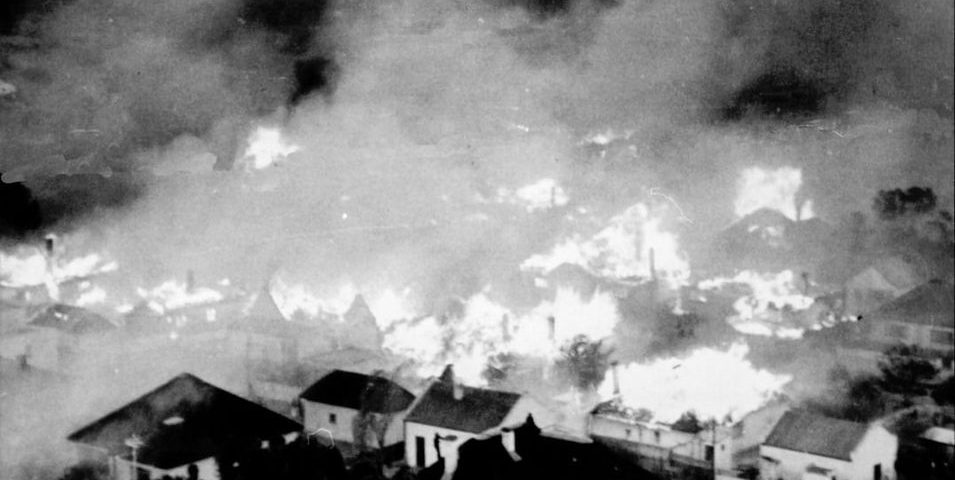
Fires in Hermanus
January 19, 2022
THE HISTORY OF THE SOUTH AFRICAN RED CROSS AND, IN PARTICULAR, THE WORK OF THE HERMANUS RED CROSS
February 1, 2022Every year one or more fires cause chaos and loss across areas of the Overstrand Municipality. These losses do not include the direct costs of extinguishing the fires – personnel, equipment, aerial services all cost. The fire in Betty’s Bay a couple of years ago is estimated to have cost the Municipality alone the sum of R10 million. The history of Hermanus itself contains stories of many destructive fires.
The year 1958 is famous for the worst fires the town has ever experienced. The most destructive of several fires that year was named ‘The Great Fire of Hermanus’ in the local media and occurred on 29 July 1958. The events were graphically described in the local newspaper and later in Arderne Tredgold’s book “Village of the Sea: The Story of Hermanus”.
The Great Fire started in the home of the Henn family on the corner of Lord Roberts Road and Moffat Street, Eastcliff. With a northwest gale behind it, it destroyed 23 houses, most in Luyt Street. It is believed that the original spark that set alight the thatch came from an help. Ironically, residents’ concern and willingness to help resulted in a problem in controlling the blaze. The fire engines could not get past the crowd in the streets to reach the fire. Well-intentioned persons tried to save household items but only succeeded in obstructing firefighters, and there were suggestions of looting in the confusion.
In the same year (1958), another fire was experienced in a single house at 64 Mitchell Street. This fire threatened to spread to the next-door house (which was unoccupied), but two boys (Edwin Erwee and Arthur Blood) spontaneously climbed onto the house’s roof with a garden hose and put out many small fires soon as they started. After seven hours, the house was saved.
A fire destroyed six houses in Armagh Road in Westcliff to bring the year to an end.
Several severe and destructive fires were experienced in hotel fires in the 1940s. Then, in 1956, the Seahurst Hotel was burned down.
Any hopes that the threat of fire had been removed were dashed when on 19 February 1962, the town suffered a fire almost equal to the ‘great fire’ of 1958. It started near the golf course property and moved westward with a strong wind behind it. The golf course itself temporarily hindered it, but the strong northwest wind blew embers across Main Road and houses in Eastcliff and Kwaaiwater began to burn. After the fire, it became clear that 22 homes had been destroyed and eight seriously damaged, including a house belonging to Sir de Villiers Graaff. The house was unoccupied at the time.
Although there were no deaths or casualties involved, the State President, Mr C R Swart, sent a condolence message. He later visited the sites as he had a holiday home in Hermanus.
The Town Council voted more money for firefighting services and bought more modern equipment following this fire. It also asked for suggestions from the community. It acted in respect of vacant stands on which there was inflammable growth, ensuring that the sites were cleared frequently, at the owner’s expense. If this was not done, the Municipality cleared the area and charged the costs to the owner.
The turning point was when, in 1963, the “Council ruled that no more thatch or other inflammable material might be used for roofs, and property owners could be compelled to keep their land clear of dangerous bush and trees.” (Tredgold)
There was then a long period of no hotel fires, but in 1968, the newest hotel in town, the Birkenhead Hotel in Voelklip, suffered significant but not terminal damage. This hotel had been built in the early 1950s by the Luyt family, and, in the fire, a lounge, bar and toilet were destroyed. The fire occurred on 11 December, and the hotel was fully booked for Xmas. Somehow, everyone was eventually accommodated in other hotels or holiday homes. In 1981, the Royal Hotel in the ‘central business district’ was gutted by fire, taking the Central Hotel and the Adelphi Cinema with it to destruction.
Although there have not been recent fires compared with those of the 1950s to 1980s, the danger remains very real. Housing developments have pushed deep into fynbos territory, especially on mountainsides and are very vulnerable to fires that start in the natural areas they have invaded. On the other hand, the use of iron and tiled roofing appears to have eliminated the runway fires of the past.

